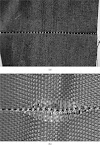Different Types of Defects In Garments, Sewing Defects
As per in every product, garments also have many defects which can cause rejection. So defects are very concerned as per quality of the garment. When a buyer puts an order it demands for defect free garments to maintain the fame in market. For that every manufacturer ensures the garments defect free by installing inspection points within the factory. This inspection is done on fabric before the production and on the product within the production line.
1.
Defects up to 3 inches = 1
Point
2.
Defects > 3 inches < 6
inches = 2 Point
3.
Defects > 6 inches < 9
inches = 3 Point
4.
Defects > 9 inches = 4 Point
Normally fabric roll containing 40 points per 100 square yard are acceptable.
In general, acceptable level are different for different fabric types. For example:
For Cotton Twill/Denim: 28 points per 100 square yards (23 points per 100 square meters) for individual fabric roll. (70.3 mtr fabric with 56" width) (60 mtr fabric with 66" width)
All synthetic fabrics: 20 points per 100 square yards (16 points per 100 square meters) for individual fabric roll
Points / 100 sq. yd. =
(Total points in roll * 36 * 100)/
(Total length in yards * width in inches)
·
While for garment inspection AQL
(Acceptance Quality Limit) is used.
The AQL
is a designated value of percent defective that the customer indicates will be
accepted most of the time by the acceptance sampling procedures to be used. It
indicates up to how much defects in garment is acceptable.
·
Inspection done on fabric for
the defects –
1.
Shade variation
2.
Width variations
3.
Shrinkage percentage
4.
Bowing and skewing
5.
Missing pick or end
dd
 |
| Source: Online Clothing Study |
·
Inspection done on garment for
defects –
1.
Needle marks
2.
Feed dog mark
3.
Loose stitch
4.
Collar checking (Collar has
zero tolerance for defects)
5.
Seam open
6.
Trimming protruding threads
7.
Shape out
8.
Seam puckering
9.
Uneven stitches
10.
Stains
11.
Garment measurements












0 Comments
If you have any doubts, please don't hesitate to ask